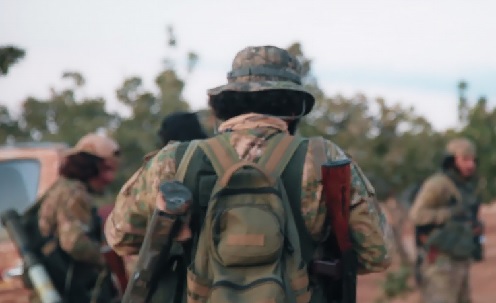How al-Qa`ida Lost Control of its Syrian Affiliate: The Inside Story
 The Syrian jihad presented invaluable opportunities for
The Syrian jihad presented invaluable opportunities for
al-Qa`ida to establish what it had always sought: a popular,
broadly representative jihadi resistance movement
that could support the creation of an Islamic government
presiding over an expanse of important territory. Jabhat
al-Nusra assumed the mantle of responsibility in seeking
to achieve this grand goal. And it did remarkably well, up
to a point. As conflict dynamics evolved, however, the goal
of transforming into a mass movement with social and political

 Since the downfall of Muammar Gaddafi, a power vacuum has led Libya down a path of factionalism and war. Isolated from both Tobruk and Tripoli’s rule, extremists and separatists thrive, leaving the future of Libya hanging in the balance.
Since the downfall of Muammar Gaddafi, a power vacuum has led Libya down a path of factionalism and war. Isolated from both Tobruk and Tripoli’s rule, extremists and separatists thrive, leaving the future of Libya hanging in the balance.
 Abstract: To date, little work has been undertaken to analyze the Islamic State’s presence in Africa from a comparative perspective. In an effort to begin to understand the broader landscape of the Islamic State’s existence in Africa, this article presents the first overview of the approximate number of fighters in various Islamic State cells in Africa as of July 2018. Leveraging a compilation of best available open-source data along with interviews with subject matter experts, the authors’ best estimates suggest the presence of approximately 6,000 Islamic State fighters in Africa today, spread over a total of nine Islamic State ‘cells.’
Abstract: To date, little work has been undertaken to analyze the Islamic State’s presence in Africa from a comparative perspective. In an effort to begin to understand the broader landscape of the Islamic State’s existence in Africa, this article presents the first overview of the approximate number of fighters in various Islamic State cells in Africa as of July 2018. Leveraging a compilation of best available open-source data along with interviews with subject matter experts, the authors’ best estimates suggest the presence of approximately 6,000 Islamic State fighters in Africa today, spread over a total of nine Islamic State ‘cells.’ Spain’s socialist government, under Prime Minister Pedro Sánchez, has promised free healthcare to migrants and says it will investigate every asylum claim individually.
Spain’s socialist government, under Prime Minister Pedro Sánchez, has promised free healthcare to migrants and says it will investigate every asylum claim individually. Today, 510 million Europeans live in the European Union with 1.3 billion Africans facing them. If the Africans follow the example of other parts of the developing world, such as the Mexicans in the US, “in thirty years… Europe will have between 150 and 200 million Afro-Europeans, compared with 9 million today”. Smith calls this scenario “Eurafrique”.
Today, 510 million Europeans live in the European Union with 1.3 billion Africans facing them. If the Africans follow the example of other parts of the developing world, such as the Mexicans in the US, “in thirty years… Europe will have between 150 and 200 million Afro-Europeans, compared with 9 million today”. Smith calls this scenario “Eurafrique”.